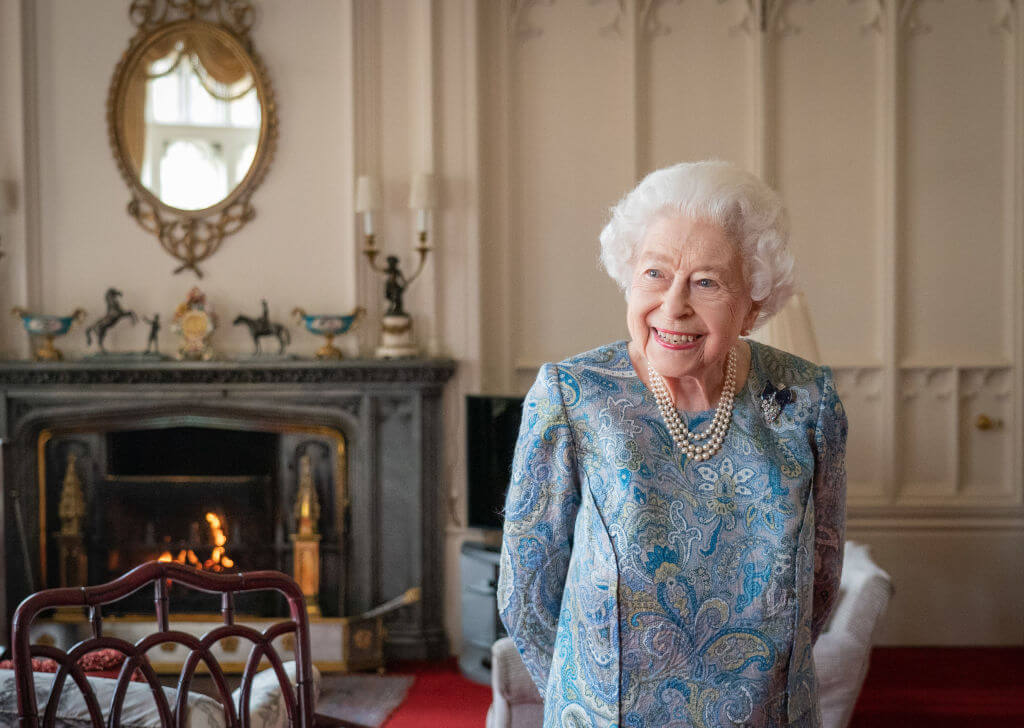First PersonAs the queen is laid to rest, a former aide remembers the most Jewish moment he witnessed by her side
‘To 120,’ a well-wisher told the monarch when she was 86, provoking amusement and bafflement

Queen Elizabeth II at Windsor Castle on April 28, 2022. Photo by Getty Images
Of all the encounters I had with Queen Elizabeth II over three years of working on the royal communications staff, perhaps the most Jewish came during the Diamond Jubilee festivities honoring her 60th year with the crown in 2012.
Vivian Wineman, then president of Britain’s Board of Deputies, wished her “to 120” at a reception, a greeting that provoked amusement and bafflement in equal measure.
Alas, the queen’s death earlier this month at 96 left her 24 years shy of the age attributed to Moses in the Torah that led to that global Jewish birthday greeting. But as hundreds of thousands of my fellow Britons queued to pay respects to our longest-reigning monarch, Wineman’s greeting was one of several powerful, personal memories in my mind.
For three years, I am proud to say, the queen was my boss. Not in the conventional sense; she did not give me a performance evaluation, send me emails with instructions or issue me with a letter of reference when I left the job. Still, from the time I was recruited to work as an assistant press secretary at Buckingham Palace back in 2009, it was a privilege to be part of an an institution whose head was respected, revered and loved throughout the world.
I staffed royal events all over the U.K.: in the valleys of Wales, the beautiful city of Edinburgh, idyllic rural locations in Northumberland and Hampshire, and of course throughout central London, including state services at Westminster Abbey, the Chelsea Flower Show and many events at Buckingham Palace itself.
Whatever the setting and whomever she met, the queen was the same. She asked short questions, she listened and she smiled. She was a model of consistency and stability.
“The queen meets thousands upon thousands of people,” a royal expert once explained to me, “and what you have to remember is that the occasion may be the most significant and memorable event in that person’s life, but for the queen it’s just another engagement.”
What was so special about Queen Elizabeth was that she made each person she met feel special and important.
The first time we were in the same room was at a reception for the president of India, Prathibha Patil, in 2009. Yes, she was small in stature, but she had presence.
As part of the palace press contingent, our staff would usually arrive at an event a few hours before the monarch to make sure all media plans were in place. What we often encountered when we arrived at the school, hospital, factory, town square or wherever she was going was a sense of nerve-fueled hysteria.
The hosts, awaiting the queen’s arrival, were understandably anxious to ensure that everything was perfect on the big day. A familiar pattern followed. The queen’s Bentley would arrive, the monarch would climb out of the car and smile, and suddenly the tortured atmosphere would be transformed into a relaxed and upbeat one.
Some of my strongest memories at the Palace relate to events involving the Jewish community. During the Diamond Jubilee reception for different faith communities at Lambeth Palace in February 2012, it was truly special to see Britain’s legendary chief rabbi, Jonathan Sacks, congratulate her. Two years earlier, it was remarkable to stand close to two diminutive leaders with huge global reach when the queen hosted Pope Benedict at the Palace of Holyroodhouse.
This is a woman who met with 13 of the 14 American presidents during her seven-decade reign, starting with President Harry S. Truman (Lyndon B. Johnson was the odd one out).
She made state visits to the U.S. in 1957, 1976, 1991 and 2007, not just meeting those commanders in chief but also having the quintessentially American experiences of a gridiron game (watching the University of Maryland beat the University of North Carolina 21-7 in 1957) and a baseball match (1991, though she left before the Oakland Athletics won 6-3 against the Baltimore Orioles ).
While I worked for the palace, we had a number of briefings about plans for the queen’s death, codenamed London Bridge. It was our good fortune never to have to roll out the plans the world is now watching unfold.
My job allowed me to travel to the various royal residences. Though I never carried out any official duties at Balmoral, we did rent a family cottage there on the estate one summer, and developed a sense of why the queen so loved it.
“Long to reign over us” forms the rousing finale of England’s national anthem. Some interpret the words as a reference to Britain’s oft-gloomy weather, but given her longevity, Queen Elizabeth II certainly fulfilled the sentiment of these lyrics.
Many people are ambivalent or dismissive about their former bosses. I am proud to have worked for a leader who embodied decency, humility and kindness. Leaving aside the formalities of her role, the the Queen’s qualities as a human being — as an “ubermensch” — will live on in the hearts of those who were privileged to work for her.
Correction: Due to an editing error, the number of years between Queen Elizabeth II’s age at death, 96, and the 120 years attributed to Moses in the bible was mistakenly set at 14; it is 24.














